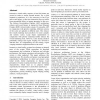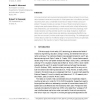5202 search results - page 137 / 1041 » A Survey of Human Computation Systems |
ACSC
2006
IEEE
15 years 4 months ago
2006
IEEE
Interactive virtual reality requires at least 60 frames per second in order to ensure smooth motion. For a good immersive experience, it is also necessary to have low end-to-end l...
EPIA
2005
Springer
15 years 3 months ago
2005
Springer
We are interested in the challenging scientific pursuit of how to characterize human activities in any formal meeting situation by tracking people’s positions with a computer vi...
CHI
2011
ACM
14 years 1 months ago
2011
ACM
Today, commodity technologies like mobile phones—once symbols of status and wealth—have become deeply woven into social and economic participation in Western society. Despite ...
CHI
2010
ACM
15 years 4 months ago
2010
ACM
When asked to draw, many people are hesitant because they consider themselves unable to draw well. This paper describes the first system for a computer to provide direction and fe...
PRESENCE
1998
14 years 9 months ago
1998
Virtual environments are envisioned as being systems that will enhance the communication between humans and computers. If virtual systems are to be effective and well received by ...


